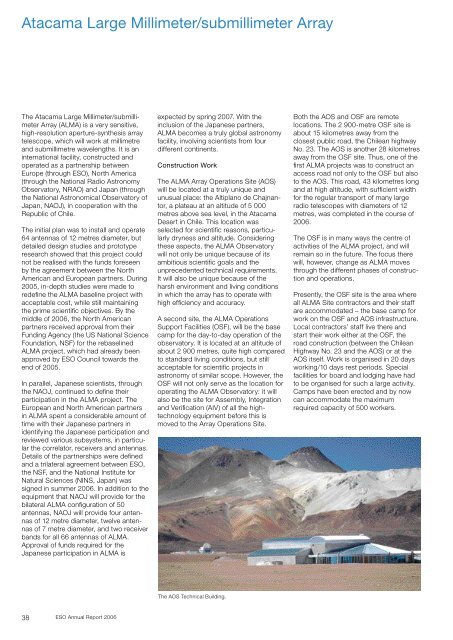Untitled - ESO
Untitled - ESO
Untitled - ESO
You also want an ePaper? Increase the reach of your titles
YUMPU automatically turns print PDFs into web optimized ePapers that Google loves.
Atacama Large Millimeter/submillimeter Array<br />
The Atacama Large Millimeter/submillimeter<br />
Array (ALMA) is a very sensitive,<br />
high-resolution aperture-synthesis array<br />
telescope, which will work at millimetre<br />
and submillimetre wavelengths. It is an<br />
international facility, constructed and<br />
operated as a partnership between<br />
Europe (through <strong>ESO</strong>), North America<br />
(through the National Radio Astronomy<br />
Observatory, NRAO) and Japan (through<br />
the National Astronomical Observatory of<br />
Japan, NAOJ), in cooperation with the<br />
Republic of Chile.<br />
The initial plan was to install and operate<br />
64 antennas of 1 metres diameter, but<br />
detailed design studies and prototype<br />
research showed that this project could<br />
not be realised with the funds foreseen<br />
by the agreement between the North<br />
American and European partners. During<br />
005, in-depth studies were made to<br />
redefine the ALMA baseline project with<br />
acceptable cost, while still maintaining<br />
the prime scientific objectives. By the<br />
middle of 006, the North American<br />
partners received approval from their<br />
Funding Agency (the US National Science<br />
Foundation, NSF) for the rebaselined<br />
ALMA project, which had already been<br />
approved by <strong>ESO</strong> Council towards the<br />
end of 005.<br />
In parallel, Japanese scientists, through<br />
the NAOJ, continued to define their<br />
participation in the ALMA project. The<br />
European and North American partners<br />
in ALMA spent a considerable amount of<br />
time with their Japanese partners in<br />
identifying the Japanese participation and<br />
reviewed various subsystems, in particular<br />
the correlator, receivers and antennas.<br />
Details of the partnerships were defined<br />
and a trilateral agreement between <strong>ESO</strong>,<br />
the NSF, and the National Institute for<br />
Natural Sciences (NINS, Japan) was<br />
signed in summer 006. In addition to the<br />
equipment that NAOJ will provide for the<br />
bilateral ALMA configuration of 50<br />
antennas, NAOJ will provide four antennas<br />
of 1 metre diameter, twelve antennas<br />
of 7 metre diameter, and two receiver<br />
bands for all 66 antennas of ALMA.<br />
Approval of funds required for the<br />
Japanese participation in ALMA is<br />
38<br />
<strong>ESO</strong> Annual Report 006<br />
expected by spring 007. With the<br />
inclusion of the Japanese partners,<br />
ALMA becomes a truly global astronomy<br />
facility, involving scientists from four<br />
different continents.<br />
Construction Work<br />
The ALMA Array Operations Site (AOS)<br />
will be located at a truly unique and<br />
unusual place: the Altiplano de Chajnantor,<br />
a plateau at an altitude of 5 000<br />
metres above sea level, in the Atacama<br />
Desert in Chile. This location was<br />
selected for scientific reasons, particularly<br />
dryness and altitude. Considering<br />
these aspects, the ALMA Observatory<br />
will not only be unique because of its<br />
ambitious scientific goals and the<br />
unprecedented technical requirements.<br />
It will also be unique because of the<br />
harsh environment and living conditions<br />
in which the array has to operate with<br />
high efficiency and accuracy.<br />
A second site, the ALMA Operations<br />
Support Facilities (OSF), will be the base<br />
camp for the day-to-day operation of the<br />
observatory. It is located at an altitude of<br />
about 900 metres, quite high compared<br />
to standard living conditions, but still<br />
acceptable for scientific projects in<br />
astronomy of similar scope. However, the<br />
OSF will not only serve as the location for<br />
operating the ALMA Observatory: it will<br />
also be the site for Assembly, Integration<br />
and Verification (AIV) of all the hightechnology<br />
equipment before this is<br />
moved to the Array Operations Site.<br />
The AOS Technical Building.<br />
Both the AOS and OSF are remote<br />
locations. The 900-metre OSF site is<br />
about 15 kilometres away from the<br />
closest public road, the Chilean highway<br />
No. 3. The AOS is another 8 kilometres<br />
away from the OSF site. Thus, one of the<br />
first ALMA projects was to construct an<br />
access road not only to the OSF but also<br />
to the AOS. This road, 43 kilometres long<br />
and at high altitude, with sufficient width<br />
for the regular transport of many large<br />
radio telescopes with diameters of 1<br />
metres, was completed in the course of<br />
006.<br />
The OSF is in many ways the centre of<br />
activities of the ALMA project, and will<br />
remain so in the future. The focus there<br />
will, however, change as ALMA moves<br />
through the different phases of construction<br />
and operations.<br />
Presently, the OSF site is the area where<br />
all ALMA Site contractors and their staff<br />
are accommodated – the base camp for<br />
work on the OSF and AOS infrastructure.<br />
Local contractors’ staff live there and<br />
start their work either at the OSF, the<br />
road construction (between the Chilean<br />
Highway No. 3 and the AOS) or at the<br />
AOS itself. Work is organised in 0 days<br />
working/10 days rest periods. Special<br />
facilities for board and lodging have had<br />
to be organised for such a large activity.<br />
Camps have been erected and by now<br />
can accommodate the maximum<br />
required capacity of 500 workers.

















